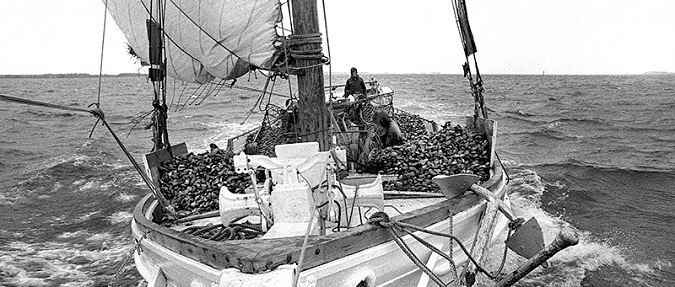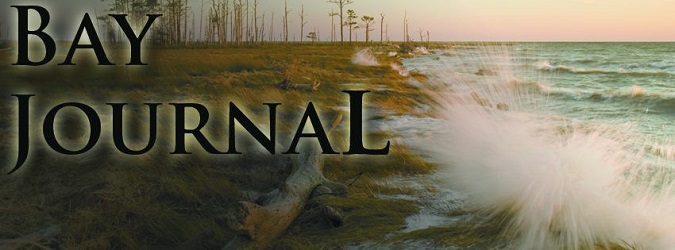
Warmer winters, rather than overharvesting, caused the steep decline of oysters and other commercially valuable shellfish in the Chesapeake Bay and elsewhere along the Atlantic coast, according to a controversial new study that’s getting pushback from some scientists.
The study, which appeared in Marine Fisheries Review, a quarterly journal of the National Oceanic and Atmospheric Administration, says that multi-year stretches of mild temperatures in normally cold-weather months altered the food web in coastal waters. That impaired the growth and reproduction of oysters, quahogs, soft-shell clams and scallops, scientists said. It also led to increased predation on shellfish larvae and outbreaks of diseases.
“The temperatures got warm and that changed the whole environment, so [the oyster diseases] MSX and Dermo could flourish,” said Clyde MacKenzie, Jr., the study’s lead author and a longtime researcher at NOAA’s Northeast Fisheries Science Center at Sandy Hook, NJ. Mitchell Tarnowski, who runs the annual fall oyster survey for Maryland’s Department of Natural Resources, is the co-author.
The paper’s conclusions, especially its dismissal of overfishing as a factor in Chesapeake oyster declines, came under fire from scientists with the University of Maryland Center for Environmental Science and Chesapeake Bay Foundation. Its publication comes as the DNR prepares to release a first-ever stock assessment of the oyster population in the Upper Chesapeake, including an evaluation of whether current harvest levels are sustainable.
The scientific consensus has long been that overharvesting, disease and habitat loss over the decades devastated the Bay’s oyster population, with some estimates putting it in recent years at 1 percent or less of historic levels of abundance. From an annual commercial harvest of nearly 17 million bushels in 1880, landings have trended downward, hitting historic lows in 2003-04 of just 50,000 bushels. The harvest has rebounded some since then, though much of the gain has come via private oyster farming, especially in Virginia.
MacKenzie and Tarnowski said they found that factors other than fishing pressure were responsible for the decline.
“In sum, the steep fall in oyster landings after 1900, was not simply a consequence of fishermen overharvesting oysters on the beds, as many scientists, including we authors, have routinely stated,” they wrote.
The overriding influence behind a coastwide decline of shellfish, the paper’s authors said, was a shift in environmental conditions brought about by a weather phenomenon called the North Atlantic Oscillation. It is an irregular fluctuation of atmospheric pressure over the North Atlantic that has a strong, wide-ranging impact on winter weather on both sides of the ocean.
When the oscillation is in its “positive” mode, with strong high- and low-pressure systems abutting each other, warmer, wetter conditions prevail over Northern Europe and northeastern North America. When the pressure differences are weaker, coastal areas experience colder, dryer weather.
Though those conditions can vary, or oscillate, from year to year, the study says that a review of weather data since the 1860s found two periods when they remained in the warmer, wetter mode for decades at a time. Coastwide, commercial oyster, clam and scallop landings fell during those periods.
The authors said that warmer waters in winter and early spring stress adult oysters and other mollusks, causing them to lose weight and produce fewer eggs. Those conditions also allow tiny crustaceans, especially hordes of speck-size copepods, to remain active, consuming the microscopic algae upon which oysters and other filter-feeding bivalves depend, they said. With less food available, the recruitment of new young shellfish suffered. Warmer waters may also have boosted the population of shrimp that prey on bivalve larvae, the scientists suggested.
The last such warming spell lasted from 1979 to 2002, the paper notes, which partially overlaps with outbreaks of the parasitic diseases MSX and Dermo in the Chesapeake and the spread of MSX to Long Island Sound off Connecticut. Harvests crashed in both places during that period.
The biologists did say factors besides the oscillation have hurt the wild harvest of oysters, including the loss of reef habitat. The Bay lost the vast majority of its historic oyster reefs to siltation, according to one 2009 report, as well as natural predators and harvest degradation.
The researchers acknowledge that watermen, in dredging oysters from the bottom, have worn down the reefs needed for new generations of oysters. As newly hatched larvae, oysters drift in the water for a week or two before settling to the bottom. They need to attach themselves to a hard surface, such as another oyster shell, if they are to survive and grow.
But the authors said that because harvesters were required by fishing regulations to return small oysters to the water, there were still enough to maintain and even rebuild the population — had other conditions been favorable.
“The general idea was it wasn’t overfishing that caused the decline,” MacKenzie said. The fisheries were essentially self-regulating, he said. As catches declined, so did the number of harvesters.
The DNR’s Tarnowski is currently on the Bay full-time conducting the state’s annual oyster reef survey and emailed that he did not have time to discuss the paper. The survey involves collecting samples from hundreds of reefs and usually lasts from mid-October through November or later.
The paper drew skeptical responses from some scientists who have been deeply involved in research on the Bay’s oyster losses and on the long-running effort to restore the population.
“There is something to these climatic cycles and the productivity of living resources,” said Donald Boesch, a professor of marine science and former UMCES president who served on Maryland’s oyster advisory commission for years. Other studies have shown how finfish migrate northward when the waters are warmer, he noted.
But Boesch said that he thought the paper lacked sufficient data for the case it tried to make. For instance, he said, he was unaware of any detailed studies that would corroborate the paper’s conclusions about the impacts of warmer water on oyster reproduction and the survival of their young.
“I think they really overextended the evidence to draw such dramatic conclusions,” he said.
Michael Wilberg, another UMCES professor who specializes in analyzing fish populations and fisheries management, disputed MacKenzie’s assertion that the Bay’s oysters hadn’t been overfished.
“It’s not to say that the environment doesn’t affect shellfish population dynamics,” he said, “but overfishing is definitely possible.”
In fact, Wilberg and colleagues concluded in papers published in 2011 and 2013 that the Bay’s oysters were overfished, with harvest rates exceeding the ability of a disease-diminished population to replace oysters and reefs lost from both natural and human-caused impacts. The earlier paper estimated that the bivalve population in Maryland’s portion of the Chesapeake had fallen to much less than 1 percent of historic levels. They recommended imposing a moratorium on commercial harvests until reefs and a self-sustaining population could be restored.
At the time, the state’s fisheries managers under then-Gov. Martin O’Malley rejected that recommendation. They did embark on an ambitious restoration effort, paired with a sweeping overhaul of the state’s oyster management. As part of that, the state vastly expanded the areas in the Bay set aside as sanctuaries closed to commercial harvest.

Under Gov. Larry Hogan, the DNR last year proposed opening some of those sanctuaries for watermen, as Maryland’s wild harvest, after a promising rebound several years ago, has been falling again. But the General Assembly blocked the DNR’s move, ordering the agency to conduct a stock assessment before making any changes in sanctuaries. That report is due by the end of this year.
Wilberg has been working with DNR biologists on their stock assessment. He’s scheduled to outline its findings at a meeting Nov. 19 in Annapolis of the state’s Oyster Advisory Commission.
Allison Colden, fisheries scientist with the Annapolis-based Bay Foundation, said she believes the paper made overly broad generalizations about the causes of oysters’ declines in the Chesapeake. And she questioned the distinction the authors made between overharvesting and loss of habitat.
“You can’t say overharvesting is not an issue, but degradation due to harvesting is,” said Colden. “If the harvesting weren’t there, then you wouldn’t have further degradation of the habitat going on.”
She also questioned the paper’s focus on trends in commercial shellfish landings data, saying that’s not a reliable way to gauge the abundance of fish. The catch can be affected by a variety of factors, including bad weather keeping harvesters on shore, declining markets or changes in fishing regulations.
Even if the North Atlantic Oscillation does influence oyster reproduction and survival, Colden said, fisheries managers need to work on what they can do to maintain and rebuild the population.
“You can’t control how much it rains,” she said. “But you can control the water quality to a certain extent, and you can control the harvest or fishing levels in the Bay.”
